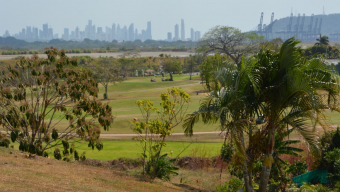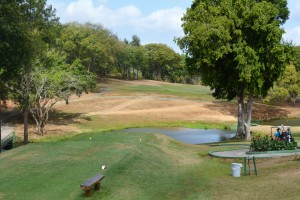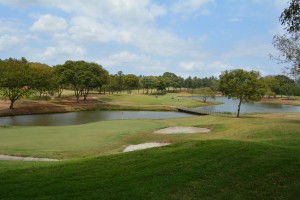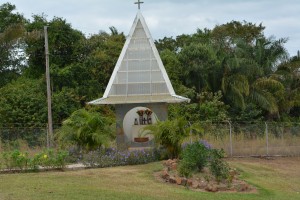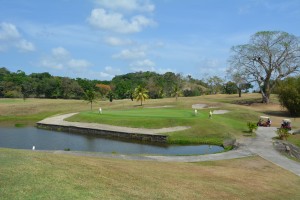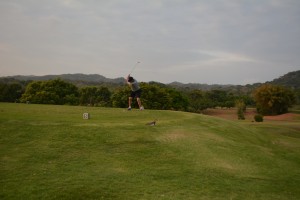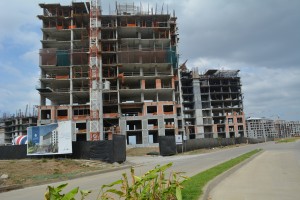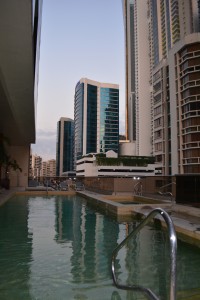Editor’s Note: During this difficult time dealing with the Coronavirus outbreak, leaving golf writers nothing to write about, we decided to revisit some of the places we have gone over the years. Today, we begin a three-part series on Panama.
PANAMA CITY, Panama – This is the one course in this country, Golf de Panama, with history, although its once hallowed ground is now a city park. This course, or rather the name, was the first one built as a nine-hole layout in 1922. It was authorized by American workers who were there to operate the Canals. In 1932, the second nine was added.
It was the pride of the local golfing establishment when it attracted players such as San Snead, Doug Ford and Arnold Palmer to play – and win – the Panama Open Championship in the 1950s.
But it was not tight course, not up to even the standards at the time. The decision was made to move 10 miles north of downtown to a 310-acre site. Nearly 40 years later, it’s a mature, lush layout with tall trees lining the fairways. It can be stretched to more than 7,600 yards.
Since 2004, it has been the venue for the Web.com Tour’s Claro Championship. That tournament opened the Web.com season in January as Ryan Armour won the event by three shots at 12-under 268.
Next January, the course will host the prestigious Latin America Amateur Championship. It’s the third year for the event, organized and promoted by the USGA, the R&A and the Masters Tournament. The winner and runner-up both earn spots in the Masters field. Argentina and The Dominican hosted the first two LAAC.
This was my favorite course in our tour probably because it reminds you so much of familiar country-club style course in the U.S. It’s challenging with quirkiness. There is no housing development around it. It has the usual water hazards and bunkers perfectly located for your drives.
The traditional style for Panama is readily apparent from the first hole (left). You drive from an elevated tee with a slight dogleg right through a tunnel of 40-year-old trees. Excellent start.
One of the great holes in the entire country is the par-5 ninth. It’s short, just 476 yards, but you have a pair of water hazards to maneuver around. Your drive appears simply, despite a large lake in front of you. But you can bite off as much as you need to the right. However, your tendency is to go straight at it because it appears closer than it actually is. I made a mistake of not waiting for my fellow golfer to tell me the distance and hit a solid drive. Then he told me. The distance was 230 yards. I hit 215, in the water.
So my third was safely to the right, too much to the right. That’s because for us first-time players, we didn’t really that the green is protected by another lake (you can’t see it from the tee or to the right). Another water ball. I think I took an eight, highest of the week, but my playing partner, a scratch golfer, was on in two. He did it right. However, no eagle, no birdie. He three-putted. Great hole.
Golf de Panama also has a fine two-lake finishing hole, a par-4, 458-yarder. You tee off over a lake, although carrying it shouldn’t be a problem. But the green is nestled right next to a alligator-infested pond. The second shot is long and perilous. Most average golfers would need to lay up or blast one to the left of the hole, where there is room.
Highly recommended course for its history and challenge.
Tucan Country Club
If you are staying downtown Panama City, which you should because of its hotels, restaurants, and amenities, this is the closest course to you. It’s two exits past the Bridge of the Americas. It used to be a U.S. military base now it’s used by the Panamanian police and military. There are several condos, many under-construction, through the layout.
We played in February, during the dry and hot season, so the course was a bit burned out despite three doses of water a day. It’s has a feel of a muni but there are some superb holes, a weaving layout and a fun finish. Plus, the people are the nicest you’ll find in the business.
The greens feature paspalum grass, which is the choice of hotter climates because of its durability. But it takes some time to get used to. You think because it’s dry and hard your putts will roll but paspalum is a little like Velcro. It can unexpectedly check up short. Be sure to test your putting on the practice green beforehand.
By the third hole, you’ll see why it’s special. The tee is elevated, the highest point on the course, and across the layout you can see the gleaming Panama City high-rise skyline along with the working shipping cranes on the Canal docks. The quintessential Panama golf-course picture (top).
The third also is interesting because of a chapel just behind the tee. The owners are quite religious and, after the first two tough ones – battling the winds – it’s well positioned.
The front nine weaves around various condos. The par-3, 151-yard seventh sits alongside the military barracks and each time we played it, the military band was blasting out the national anthem and Sousa favorites.
No. 8, a par-4 332-yarder, is quite strange in the fact that there is a huge tree directly in front of the green. You have no choice but to go over it and the closer you get on your drive the harder it is to fly it and parachute on the green.
No. 9 is a par-4, 326-yard hole that’s an optical illusion. You might not think you have enough club to carry the ditch, halfway to the green, on your drive but it’s really only about 175 yards out, 190 to carry. Most of us should fly it but many chose to lay up.
The Tucan back nine is the better side and where the wind comes more into play, especially on the simple 144-yard, par-3 11th. With the prevailing wind coming at you or left-to-right, you either have to hit low or aim 20 yards to the left of the green to have a chance. But we did have a near ace in our group.
There are some fun holes on the back, every other hole with and against the wind. It’s a good finish, with a par-3, 149-yard par-3, from an elevated tee to an elevated green, above water and a bunker the entire length of the green.
The par-5, 594-yard 18th looks like a mile from the tee but that’s deceiving. You are generally with the wind here so your tee shot, on the hard surface, can motor. In fact, my three-wood second shot, about 230-yard-plus, unexpectedly rolled into the group ahead of us as they we leaving the green. I felt great about it; they didn’t. That resulted in the first birdie of the tour.
The food is surprisingly good in the restaurant, so is the national beer, Balboa, but one of the things that you find in most of the pro shops, there are few items with the course’s logo on them. That’ll change as the country picks up more foreign visitors.
If you are in Panama for a short time, or, say, have the day free off a passenger ship, you can get to this course quickly and it’ll get you a nice flavor of the country.
Summit Golf Club
Not far from the city, and just to the east of the Gaillard Cut of the Canal, the Summit Golf Club sticks out of a rain forest. As you approach, you see the Radisson Hotel that sits at the high point above the course. This is clearly cut out of a rain forest, the Camino de Cruces National Park.
From different perspectives around around the course, it has the same look and feel of a island course, such as Kauai’s Princeville.
Like Golf de Panama, Summit course has longer history. It was originally built in 1930 to service the American Canal workers. You can see by the layout it has a traditional pattern.
However, what you notice right away, from the first hole, is bizarre routing, altered recently from its original intent. It was changed to consolidate one starter for the 18, instead of one for each nine. That has complicated the course, not for the better.
Your first tee shot on the 6,6683-yard course, is a blind shot. You really not sure where the green is. The terrain takes you to the left and inevitably you will end up near or into a shallow storm drain. You can’t hit out of it – I’m sure the local rule allows for a drop – but you also may not find it because of a high volume of leaves. Those storm drains and inconsistent with golf play. They should be either covered or the leaves removed daily.
Then after No. 1, you have to walk back about 150 yards to the next tee, heading just to the left of the green you just played. When you get to No. 3, you’re not sure if you should hit back toward the hotel (that’s No. 7) or further into the forest. And No. 3 green is adjacent to No. 5 green, too close for safe play.
After the first few holes it does weave into a more accommodating layout. It has the potential to be a fine course but right now it’s a bit frustrating.
What’s nice about it is the green are Bermuda grass, not paspalum, which, I find, makes for easier reads and truer rolls.
What’s worth it, however, is the stay. The hotel has a spa feel to it with a friendly, beautiful staff. There’s a butterfly habitat behind the hotel and great walking areas through the forest.
Santa Maria Golf and Country Club
This one could be a jewel of the region when all the construction is finished but most of us might never know it. It’s a private, real-estate development with at least a half dozen condos under construction and many private homes all around.
You’re going to have to buy property on the 700-acre site, just on the outskirts of Panama City. That allows you to buy a $40,000 membership for the Jack Nicklaus-designed layout. There’s enough opportunity to get into the market, with all the condos available, if you have the means.
The course is magnificent in appearance, vast, green, long. It’s also near the water so the wind will be your constant playing partner. Combined with the course length, 7,196 yards, and the strong headwinds, this is a Bear. Frankly, it’s not inviting for the average golfer because of those factors, even if you can get on it.
Where to stay, eat: There are deals to be made in Panama City, which is a bit overbuilt, as its 42 percent occupancy rate attests. We stayed at three places in the the area, all that can be recommended, Bristol
Hotel and Waldorf Astoria in the city and the Radisson where Summit is located. The Waldorf has a wonderful seventh-floor, open-air pool that’s pretty cool.
One suggestion for dinner that involves traditional folk dance is the Las Tinajas Restaurant in the city. It features sea bass – with coconut sauce – and an evening of folk dance with the women dressed in the elaborate pollera dressed.





